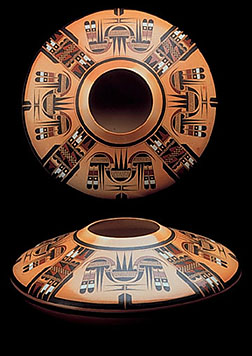Introduction
The different tribes of American Indians were responsible for creating a variety of traditional arts that were used for various purposes throughout the tribes. These art works were used in spiritual rituals, personal decoration and occasionally for trade purposes. Therefore it is important when researching art created by these diverse tribes to limit the area of study to either one geographic area or one tribe. This paper is interested in exploring the art work created by Native Americans located in the southwestern portion of the United States.
The Pueblo society has managed to retain many of their traditional cultural lifestyle. This includes their community organizations, religion and art work. It has not been possible for them to completely avoid outside cultural influences. They have added new forms of livestock, clothing and religious influences (Dozier, 80).
The Southwest area of the United States has the oldest continuous record of habitation inside America’s boarders. Researchers have discovered the remains of three southwestern cultures that had started to evolve by the beginning of the Christian era. These cultures were the Hohokam who probably evolved into the Pima and Papago Indian tribes located in Arizona, the Mogollon who were the precedents of the Mimbres culture, and finally the Pueblo Indians whose culture reached its zenith during the 11th century. The Pueblo Indian civilization expanded to include the Four Corners area of Colorado, Utah, Arizona, and New Mexico). Most of these ancient cultures vanished by the twelfth century, but the Pueblo and Navajo cultures continue today.
Today, Southwestern pottery made in the existing twenty pueblos in New Mexico and Arizona, and by the Navajos in Arizona, remains one of the greatest expressions of ceramic art in the world (Peterson). Due to the continuity of these Indian cultures the teachings of one generation are passed intact from one generation to the next. Because the traditions are continued very little of the cultural information that allows these beautiful works of art to be continued.
The writer is interested in examining the history and culture of the Pueblo Indians and the modern culture in order to determine if modern influences on the culture have influenced the art work produced by the tribes.
Pueblo Indians
The Pueblo Indians have managed to preserve their culture through several important culture shifts. These shifts included the arrival of the Spanish, the atrocities committed by the Spanish as they worked to expand their borders and maintain what they had taken by conquest as well as to protect themselves from the diseases that the Spanish brought. After maintaining their culture through these upheavals they were reassigned their tribal lands by the American government. They were allowed to return to their lands due to their remote nature. The Pueblo Indians in general have worked to avoid integration up to and including marrying within the Native American tribes rather then marrying those who claim European descent. These isolationist policies have allowed them to maintain their culture in an increasingly modern world (Anderson).
The Pueblo Indians live in housing that is built out of clay or lava rock which is then plastered with lime and straw to enhance their stability. Because the Pueblo Indins live in a dessert environment they have to bring the support beams for their houses from a great distance. While these building practices make it difficult for them to expand their houses the distance assists in protecting their cultural values. One of those values is the obligation to participate in the ritual life of the Pueblo Indians. This obligation only extends to the individuals who live in the traditional housing. However the Pueblo Indians that live on the reservation will offer their support when they are asked to do so (Anderson).
The Pueblo Indians are rooted to there historical home and historical culture. This can be seen when examining their isolationist tendencies as well as their restraint in other matters such as marrying outside the Pueblo. If an individual does marry outside of the group they do so knowing that it will cost them their membership in the group. As a result of the isolationist tendencies they question the presence of outsiders using their cultural differences as the means to separate themselves from modern cultural influences (Anderson).
Another method used to maintain the Pueblo culture is keeping the population of the Pueblo small and engaging in rituals designed to enhance and maintain the culture among the individuals living as part of the group. Through the teachings of traditional dances, songs and folklore to young children it is possible to instill the necessary pride and distrust of outsiders that is required to maintain the integrity of the culture (Anderson). Many of tribes such as the Navajo and Cherokee have regular celebrations in which aspects of their culture are taught and remembered. However the Pueblo are able to live their culture every day through the choices made over the last several hundred years.
Pottery Beginnings
The beginnings of pottery in the United States have been traced back 2000 years coinciding with the beginning of agriculture (Plog, 670). With the beginnings of agriculture it was necessary to find ways to store the product from the field through the winter months as well as to store the seeds that would assist the farmers during the next years planting. Due to this there are cultural differences in the shape and form of the pottery. As the original impetuous of the creation of these first pieces of pottery was form rather then aesthetics there was very little attempt at decoration.
Indian pottery is known to be very fragile which caused many of the prehistoric pots to break during the creation or during there day to day use. Because of this fragility there are very few examples of the early Pueblo pots.
The pottery displayed in Figure 1 was recovered from a pre-historic pueblo and is currently on display in New Mexico. This pot was created by wrapping coils of clay in circles and then pinching the coils together using in order to make the pot more waterproof. Because the functionality of the pot was the focus of the artist there is no attempt at smoothing the pot or creating some sort of design.
Modern Pottery
When examining Pueblo pottery created during the 1900’s it is important for the reader to understand that the Pueblo culture is made up of several separate and distinct tribes. As the tribes are descended from the same source they are all considered to be Pueblo. In this section the writer will examine several of the offshoot branches of the Pueblo tribe in order to examine how the creation and design of pottery has evolved in that tribe. This paper will examine pottery created by the Acoma, Pojoaque and the Hopi. It is believed that the work created by these tribes will provide the reader with a solid understanding of the various patterns and designs used by these separate tribes.
These three tribes have experienced similar inroads to their culture because of influence of European settlers. Each of these tribes have created different mechanisms to protect the values of their tribes while maintaining ties to their culture. These tribes were selected because each tribe chose a different response to these influences. These differences provide the reader with a better understanding of the effect that the merging of the two cultures created.
Acoma
When translating the word Acoma to English it is translated to “People of the White Rock” The Acoma pueblo is located at the top of a mesa placing their homes above the surrounding landscapes. By placing there home in this location provides added protection from enemies. This location also provides panoramic views of the landscape allowing the individuals living in this location to surround themselves with beauty. Individuals of the Acoma tribe live in other areas of the reservation other then at the top of the mesa. However there are always at least several families living in the traditional homes in order to care for the homes built by their ancestors.
Pottery created by the Acoma tribe is generally created with white clay with very thin walls. The designs that are used involve rainbows, parrots, and geometric designs. In the late 1940’s the traditional geometric designs were adapted into more contemporary versions (Bunzel, 28). Additional contemporary designs include the double dot design which symbolizes raindrops and the addition of symbols to represent other forms of water. For a culture that lives in a dessert environment receiving enough water is necessary for the tribe’s survival (Bunzel, 28). Because of the importance of water to this culture symbols of water are prevalent in the designs created by the Acoma. The below image is a collection of these forms of potteries providing the reader with a visual example of the artwork of the Acoma. The first image is an example of the traditional design of Acoma pottery.
Figure 2 located in the appendix shows the influence of the modern world onto the artwork of the Acoma tribe. The creation of animals as well as the traditional bowls shows an increased willingness to interact with the modern world at least in matters of trade and commerce.
Figure 3 located in the appendix depicts a more modern approach to the pottery created by the Acoma. The incorporation of animal shapes has been used to increase the income provided by the pottery. While this is a departure from the traditional forms created by their ancestors it provides a unique glimpse into the cultural values of the tribe. These values remain similar to those of their ancestors even through slightly more modern imagery have been included.
In another departure from traditional creations of the Acoma some of the Acoma artists are moving away from using the white clay that is prevalent in their traditional works. Due to the difficulty in working with the raw material many of them are purchasing clay from neighboring tribes and decorating the clay with a combination of the traditional and contemporary Acoma designs (Bunzel, 29).
Pojoaque
The Pojoaque tribe was historically difficult to find. Due to the location of their homes many invaders often traveled past their villages on their quest to gain more control over the native population. While the European settlers were unable to locate the majority of their villages the Pojoaque were not as lucky when it came to the diseases that traveled with the Europeans. These diseases caused so much devastation that the Pojoaque were forced out of their homes in order to survive (Bunzel, 96). Due to several drastic occurrences the traditional home of the Pojoaque was abandoned several times; however as the tribe worked to rebuild itself after each incident members of the tribe returned to their traditional lands. In the 1930’s individuals of the tribe responded to a tribal call requesting members of the tribe to return to there traditional home. Shortly after that call enough tribal members returned to receive federal assistance in creating a reservation in this area. Currently the tribe has over 200 members living on the reservation.
In each of these migrations the individuals of the tribe were exposed to outside cultural influences, however the tribe has demonstrated a deep connection and commitment to their historical traditions and the willingness to return to the traditional living arrangements and location of the ancestors.
The pottery traditionally associated with the Pojoaque was unadorned clay mixed with shards of mica. The mica created a sparkling effect making it unique to this tribe. This can be observed in Figure 4 located in the appendix.
Currently the Pojoaque tribe is on the rebound allowing the tribe to move back to their traditional homes. As an example of another form of connecting with the past the artists of this tribe continue to use the traditional methods and materials in their pottery. They have also not used images as decoration of the pots as other tribes are known for. By continuing to use the traditional methods and materials the tribe is able to maintain a connection with their ancestors that could have been damaged by the modern worked. The tribe continues to sell there unique form of pottery to collectors and tourists providing a source of economic stimulation for the tribe.
Hopi
The Hopi tribe can be located in the Southwest portion of America. Traditionally the Hopi would live in small groups of villages or pueblos. It is believed that the name Hopi was taken from the longer Hopi word Hopituh which translates to “peaceful ones”. By the 16th century the Hopi had developed successful architecture, crafts and farming. In order to preserve their traditional ways of life and prevent warfare with other tribes located in this area led to complex trade arrangements.
Pottery created by the Hopi Indians has undergone several evolutions and modifications. The first Phase occurred during the years 800 and 1300 A.D. During this phase there was more concern over the functionality of the piece instead of creating art.
The pottery displayed in Figure 5 located in the appendix, is believed to have been created sometime between the years 1325 and 1375. The artistry presented here are early indications of the designs created in the Sikyatki style.
The second phase lasted through the years 1400 through 1600 A.D. During this period the artist were known to use a form of polychrome decoration on white slip pottery.
Figure 6 is an example of Sikyatki Pollychrome bowl that was created between 1350 and 1625. This item is a classic example of the work produced during this time. The curved lines used to create the image have been found in other examples of pottery created during this time period. When shards of pottery created during this time were discovered in an archeological site it created a desire in the artists of the tribe to attempt to recreate the pottery created by their ancestors.
The third phase is known as the Revival phase which started in the year 1870. In this time pottery that had been created during the second phase had been rediscovered initiating the Hopi’s return to creating the pottery created with the polychrome pottery.
The Hopi pottery being created today is a mixture of modern techniques with ancient designs. The pottery is created from local clay that when fired in a kiln range in color from a cream color to a light orange. In order to receive the best result after firing the artists will polish the clay with various paints creating the desired design. After the artist is satisfied with the piece it is fired in kiln bringing out the colors that declare the work one that is created by a Hopi artist.
Conclusion
While researching the history of the Pueblo tribe and some of its offshoots the writer saw that many of the traditional methods for creating the work have been maintained through the centuries.
The pottery created by the Acoma has undergone the most transformation over the years resulting in more contemporary designs and shapes. The Acoma have begun to create pottery animals as well as more contemporary designs which allow the Acoma to incorporate more designs from the natural world. These designs while shown in some version of the form in the historical pottery have been expanded upon. In addition to modernizing the designs displayed on the pottery, many Acoma are beginning to move away from the traditional white clay which was one of the characteristics of their pottery. This has been done to decrease the amount of work that is required to create one of their contemporary pieces of pottery.
Of the three tribes that were examined in more detail only the Pojoaque are still using both the traditional methods of creation as well as following the tradition of allowing the materials of the pottery to shine without adding additional details or designs. The clay infused with the mica provides a subtle shine and glimmer that distinguishes the Pojoaque pottery from other tribes.
When considering the Hopi tribe the research has shown that they have spent the last hundred years learning how to recreate a traditional form of pottery unique to there culture. This focus on revitalizing their art has resulted in the creation of art that is unique to their tribe. The artists who create these works will spend up to forty hours per piece of pottery which is an indication of the amount of effort and care that the Hopi are willing to undergo to create a work that is true to the traditional beliefs of the Hopi Indian.
While the Hopi are willing to spend the necessary length of time creating there pottery the researcher was surprised to find authentic Hopi pottery being sold on ebay.com. This apparent dichotomy surprised the writer. While the artists are working on recreating the traditional form of their tribe’s pottery various artists are incorporating the benefits of modern technology into the ancient craft.
The question that this paper was attempting to answer was to what extent have the traditional art such as pottery been affected by the modern world. The Pojoaque tribe displays the least amount of modern cultural influence in the work. The writer believes that a possible reason for this tribe showing the least amount of modernization in their work due to the limited amount of interaction with more modern cultures.
The tribe that showed the most affect by the modern world in their pottery was the Acoma. The Acoma tribes have incorporated additional designs and more forms for their pottery then the traditional bowl, plate or jar. Through this evolution of their pottery indicates that the tribe is attempting to succeed in the modern world by creating traditional items with more appealing to the modern consumer.
The conclusion drawn by this writer is that the amount of cultural influence displayed in the pottery is a reflection of the amount of interaction that tribe has had with the modern world. The writer believes that it would be beneficial to do additional research on the Hopi Indian tribe to discover how they are able to combine the traditional methods of creating pottery with modern marketing techniques.
References
Women Artists of the American West. 1997. The National Museum of Women in the Arts. Web.
Bunzel, Ruth L. The Pueblo Indians of North America. Holt, Rinehart and Winston, Inc, 1970.
Dozier, Edward. “The Pueblo Indians of the Southwest: A Survey of the Anthropological Literature and a Review of Theory, Method, and Results. Current Anthropology, 5.2, (1964): 79-97.
Keegan, Marci. Pueblo People: Ancient Traditions, Modern Lives. Clear Light Publishing, Santa Fe, 1999.
Plog, Stephen. “Exploring the Ubiquitous through the Unusual: Color Symbolism in Pueblo Black-on-White Pottery”. American Antiquity. 68.4, (2003): 665-695.
In loving memory of Rose Chino Garcia, 1928-2000. Carol Synder Halberstadt, Migrations.
A Nampeyo Showcase. 2000-2007. The University of Arizona.
Art of the Southwest. 2000. Canyon Country Originals. Web.
Appendix
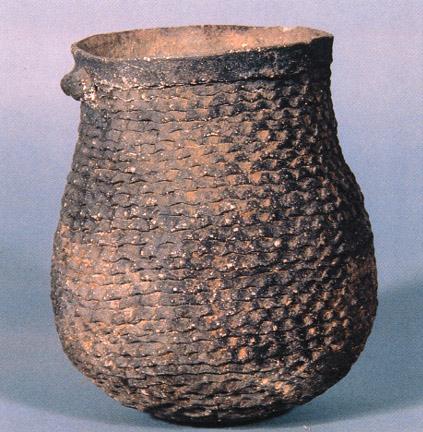
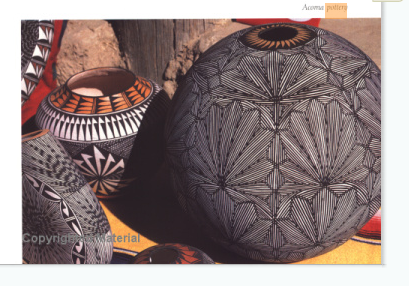
Figure 2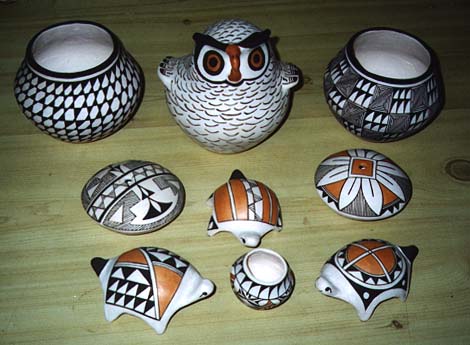
Figure 3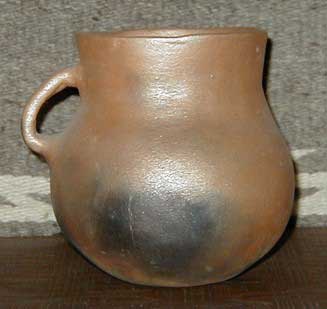
Figure 4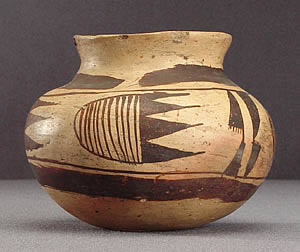
Figure 5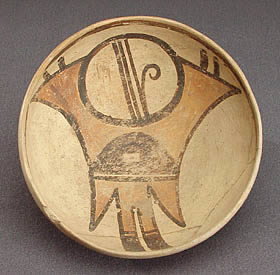
Figure 6